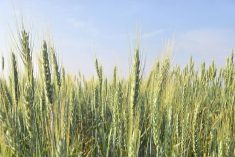WINNIPEG — Most of Saskatchewan’s crops were in good condition as of July 14, but many were also falling behind in development, according to the latest crop report from the Saskatchewan Ministry of Agriculture.
Though some farmers are still dealing with excess moisture and flooding problems, recent warm weather has helped many crops recover from the flooding stress.
As of July 14, winter wheat was 64 percent in good to excellent condition across the province, with spring wheat at 76 percent good to excellent. Oats were 66 percent good to excellent, while 62 percent of canola was rated good to excellent.
Read Also

USDA considering economic aid for farmers this fall, says secretary
The U.S. Department of Agriculture is working with Congress to evaluate whether economic aid might be needed for the nation’s farmers this fall amid trade disputes and record-high yields, Agriculture Secretary Brooke Rollins said on Monday.
Across the province, 50 percent of fall cereals were behind normal development, with 57 percent of spring cereals, 61 percent of oilseeds and 54 percent of pulse crops also behind.
The crops were furthest behind in the southeast part of the province, where most of the flooding problems have occurred, the report shows. The most advanced crops were in southwestern Saskatchewan.
Topsoil moisture conditions continue to improve across the province, as 17 percent of the land had surplus moisture, 73 percent adequate and 10 percent short. Hay land and pasture topsoil moisture was rated as 13 percent surplus, 74 percent adequate, 11 percent short and two percent very short.
Reported crop damage was linked to localized flooding, hail and wind. Cutworms, wheat midge, grasshoppers and diseases such as leaf spots and root rots were also causing problems for Saskatchewan farmers, causing them to work on controlling diseases and insects.
Many producers were haying, with 25 percent of the 2014 hay crop cut as of July 14, down slightly from 29 percent cut in 2013. Of the hay cut, 15 percent had been baled or put into silage.














